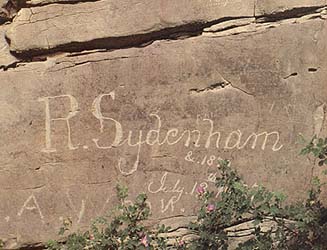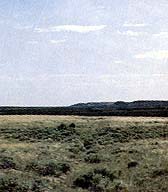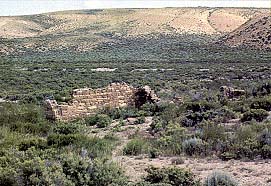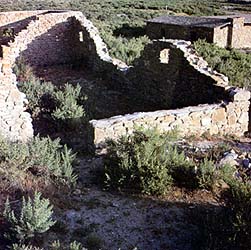“Another Route to Zion: Rediscovering the Overland Trail,” Ensign, June 1984, 34
Another Route to Zion:
Rediscovering the Overland Trail
Brigham Young and the early pioneers established a route that many thousands of Latter-day Saints would follow west—the Mormon Trail. But recent studies show that 20–25% of the pioneers followed another route across the plains of Nebraska and Wyoming.
When the first company of Latter-day Saint pioneers made their way westward from Winter Quarters to the Salt Lake Valley in 1847 under the leadership of President Brigham Young, they established a route that many thousands would follow by wagon, handcart, horseback, and on foot until the railroad reached Utah in 1869.
From Winter Quarters and several other points of departure, the emigrant Saints followed the Platte and North Platte rivers to Fort Laramie, Wyoming, continued up the North Platte and Sweetwater Rivers to South Pass and from there on to Fort Bridger and thus to the valley of the Great Salt Lake.
But research now shows that this familiar trail was not the only one used by the Saints across Nebraska and Wyoming. Recent studies have noted that odd references to another trail keep showing up in emigrant journals. After a thorough study of hundreds of Mormon and non-Mormon journals, emigration figures compiled by early Church historian Andrew Jenson, original survey plats, old and new maps, and three seasons of field research, the pieces slowly fell into place. Another trail, long forgotten, though used by thousands of Saints throughout most of the great emigrant period of 1847 to the coming of the railroad in 1869, emerged from the records to be mapped, followed, and photographed. This trail is that section of the once well-known Overland Trail which led from Fort Kearney, Nebraska (where four major routes west began), nearly eight hundred miles to Fort Bridger, Wyoming—the heaviest-used westward trail of the 1860s. (See accompanying map.)
There exist at least sixty-five Latter-day Saint emigrant accounts of travel on parts of this trail. The first account dates from October 1849, when Job Smith, an early missionary, first used it en route from the valley of the Great Salt Lake to his assignment in England. The last is dated September 1868, when the last company of Latter-day Saints to go west by wagon left the Union Pacific railhead (now defunct) at Benton, Wyoming.
Nobody knows how many Latter-day Saint emigrants, missionaries, leaders, freighters, and teamsters traveled eastward and westward along this trail during those twenty years. But an analysis of trail and journal statistics suggests that from 20 to 25 percent of the approximately sixty thousand Saints who came west used all or part of this newly discovered trail.
There were at least six reasons why so many of the Saints preferred the Overland Trail to the Mormon Trail:
1. It was shorter.
2. Sometimes feed for livestock was more abundant on the more southerly route.
3. Sometimes the Saints were trying to avoid cholera, a hazard to humans, and the bloody murrain, a disease that attacked their animals. Both diseases were often prevalent on the northern trail.
4. After 1862 there was an upsurge of Indian trouble along the Mormon Trail.
5. In 1864, the “jumping-off place” for westering Latter-day Saints was changed from Florence, Nebraska, which was north of the Platte River, to the settlement of Wyoming, Nebraska, which was south of the Platte. (See Ensign, February 1980, p. 33.) This change alone reduced the distance emigrants had to travel by boat from the railhead (then at St. Joseph, Missouri) to their new point of departure by about one hundred miles.
6. Finally, the Union Pacific Railroad, which the pioneers used from 1867 on, generally followed the more southerly Overland Trail across western Nebraska and all of Wyoming.
The portion of the Overland Trail in Wyoming, especially between Fort Bridger and Cheyenne Pass, had been scouted eastwards in 1850 by Captain Howard Stansbury of the U.S. Topographical Engineers, who was looking for an “overland trail” south of the Mormon-Oregon Trail in order to avoid the heavy snows of the more northern route. Stansbury was guided by Jim Bridger and accompanied by a Latter-day Saint engineer, Albert Carrington, who kept an extremely detailed journal of the exploring party. Actually this southern route had been known to fur trappers as early as 1825 and was often referred to as the Cherokee Trail, because a party of Cherokees went that way in 1849 en route from Oklahoma to California.
However, the Wyoming portion of the Overland Trail did not find much use until after 1862 when the postmaster general ordered that the mail route be changed from the Mormon-Oregon Trail to the Overland Trail as a result of a great increase in Indian (mainly Sioux) troubles along the northern route. These Indian uprisings were a direct result of whites settling on (rather than passing through) Indian lands, the subsequent mistreatment of the Indians, and the recalling of the U.S. Army troops from the West for action in the Civil War. The Indians along the Mormon-Oregon Trail seized this opportunity to try to get their lands back, and for the first time they began to raid in large parties of several hundred strong rather than in small bands of twenty or thirty.
The LDS Experience on the Overland Trail
In the 1840s, Latter-day Saint use of this trail was very limited. I have found only two written accounts, one by Job Smith and one by Jessie Crosby. Both went eastward in 1849 from Salt Lake City to missions in England via Fort Laramie, Ash Hollow, and Fort Kearney.
From the 1850s there are at least thirty-five Latter-day Saint accounts of use of the Nebraska section of this trail, including the writings of Joseph Young, Shadrach Roundy, John Brown, Perrigrine Sessions, Richard Ballantine, Truman Angell, Albert Carrington, and Martha Heywood. All of these Saints would have crossed the Platte River at the Lower California crossing (see map) and, proceeding via Ash Hollow, picked up the Mormon-Oregon Trail at Fort Laramie.
If their skimpy accounts are accurate, none of these Saints had much trouble with Indians along the Overland Trail. One instance recorded was at Fort Kearney, where John Brown found some Indians “very saucy” in demanding gifts. There were several deaths, however, in 1856. Almon Babbit, Utah’s delegate to Congress, and two other men were killed by Cheyennes west of Fort Kearney.
From the 1860s, at least thirty emigrant accounts have survived, including those of Zebulon Jacobs, Henry Ballard, Jessie N. Smith, Jonas Myers, and Ruth Evans. The majority of these pioneers followed the Overland Trail beyond the Lower California Crossing to the Upper California Crossing and thence via Lodgepole Creek, Cheyenne Pass, across the Laramie Plains, and through Rattlesnake and Bridger passes to Fort Bridger and on into the Salt Lake Valley. (See map.)
These Saints witnessed, directly and indirectly, many more Indian problems than previous emigrants. Several of them report having seen wagons, ranches, and stage stations burned along the trail, and sites where men had been killed and women and children taken captive. They also saw strengthened fortifications along the trail.
The Saints themselves, however, had relatively little trouble with the Indians. Some had to pay tolls in salt, beans, flour, and other commodities, but generally they were left alone—perhaps the result of the Saints’ long-standing and well-known fair treatment of the Indians, the fact that the Saints did not settle on Indian lands in Nebraska and Wyoming, and the Saints’ general preparedness.
There were, of course, deaths from various causes among the Saints on all the trails. During the 1860s at least three elders returning from English missions died on the Overland Trail. In 1864, John M. Kay was buried on the banks of the Little Laramie River; and in 1867, Brigham Willard Kimball, son of President Heber C. Kimball, died along Lodgepole Creek approximately where Kimball, Nebraska, is today. (The city is named after a railroad builder, not the missionary.) Also in 1867, Anson V. Call, son of Anson Call, was buried at the Rock Creek stage station in a now totally unkempt cemetery near present-day Arlington, Wyoming.
Although the Union Pacific Railroad started west from Omaha on 19 July 1865, it took nearly a year to lay the first 100 miles of track, and Latter-day Saints did not consider the train worthwhile to ride until the track reached North Platte, some 280 miles west, in 1867. Thereafter it appears that every emigrant company took the railroad from Omaha to its various railheads at Julesburg, Colorado, and Cheyenne, Laramie, and Benton, Wyoming. This means that most, if not all, of the approximately 4,000 Saints to go west during the last two years of the pioneering period followed parts of the Overland Trail.
That portion of the trail used by the Saints who rode the train during 1867 and 1868 could be picked up at the various railheads between North Platte, Nebraska, and Benton, Wyoming. Those relatively few who detrained at North Platte could have either stayed on the Mormon Trail or crossed the Platte River to the Overland Trail.
From the Julesburg railhead, emigrants could have gone west via Fort Laramie or Bridger Pass. Some probably did both. From Cheyenne and Laramie, it seems certain the emigrants proceeded via Bridger Pass. At Benton, the last railhead before the railroad reached Promontory Point, emigrants had a choice of taking the Overland Trail south of Rawlins Springs or going due north via Muddy (or Whiskey) Gap to pick up the old Mormon Trail along the Sweetwater River.
Train travel solved some problems but created new ones, and west of the railheads some old problems remained. The principal new problems were the vices prevalent at each of the freewheeling railhead communities, from which leaders were anxious to protect emigrants. Zebulon Jacobs called Benton, which no longer exists, “the wickedest little town of its size in existence. It is peopled with the scum of creation of both sexes.”
The Saints still experienced some Indian troubles. Many journals comment on Indian destruction, and in 1867 Anders C. Jensen was killed near Bridger Pass while enroute to Julesburg to pick up a threshing machine for his father.
After the Union Pacific Railroad reached Utah in 1869, most emigrants, including the Saints, ceased using the Mormon Trail as well as the Overland Trail. There is some evidence, however, that Latter-day Saint freighters used the Overland Trail until at least 1890. At the North Platte crossing there is a large “name cliff” covered with more than a hundred scratched and painted names dating mostly from the 1870s and 1880s. One of these names is that of “N. Nelsen, SLC, Ut. 1890.” Research to date has revealed little about this person, but he was probably a Latter-day Saint teamster from Salt Lake City who took the Overland Trail on his way east.
Today the Overland Trail is disappearing fast, and as it goes so goes a part of our heritage. The Mormon Pioneer Trail Foundation will cooperate with individuals and groups, in and out of the Church, to better protect, preserve, and especially to commemorate the sites that mark the passage of the Latter-day Saints who used the Overland Trail.
The Overland Trail Today
The Overland Trail today is roughly paralleled by U.S. Highway 30 and Interstate 80. And for those who are willing to take to the dirt roads with rough-terrain vehicles and detailed maps, a much closer look at much of the trail’s eight-hundred-mile length is possible.
Between Fort Kearney and the Upper California Crossing, there are at least forty-six trail markers—only three of which refer to the Mormons, however, and then only to the Mormon Trail on the north bank of the Platte River. Latter-day Saints will be most interested in the markers at Fort Kearney; another marker on the west side of U.S. 183 at its intersection with the good country road that comes west from Fort Kearney (this one refers to the Mormon Trail on the north side of the Platte); the 1864 Plumb Creek Massacre Cemetery fourteen miles farther west; the two markers which mention the Mormon Trail at the rest areas on I-80 five miles east of Cozad; the Midway Pony Express Station south of Gothenburg; the Fort McPherson area; the markers pointing out the trail ruts at the O’Fallon Bluffs rest areas on I-80 about eighteen miles west of North Platte (the ruts in the east-bound rest area are some of the very few Overland Trail ruts left in Nebraska); the Lower California Crossing marker on Highway 30 four miles west of Brule; and the Fort Sedgwick (which existed from 1864 to 1871 for the protection of emigrants) and Upper California Crossing (sometimes called the Mormon Crossing) markers at Ovid, Colorado.
In Nebraska west of Julesburg, Colorado, there is little remaining evidence of the Overland Trail, and in Wyoming the trail is hard to find and not well marked. There are, however, at least nineteen trail markers and a scattering of Bureau of Land Management concrete posts along the trail in Wyoming—none of which refer to Mormon pioneers. The most important are at the site of Camp Walbach, which in 1858–59 existed at the mouth of Cheyenne Pass twenty miles northwest of Cheyenne, Wyoming; at Fort Sanders, which was built in 1866 to protect the overland mail and the construction of the railroad, two miles south of Laramie on Fort Sanders Drive; at the site of the Big Laramie Crossing, about six miles west of Laramie on the south side of County Road 230; about eight miles west of Laramie on the north side of County Road 130, where some good trail ruts may be seen; at the Rock Creek Stage Station in Arlington, Wyoming, where Anson V. Call is buried; one mile west of a country road from a rest area on Interstate 80 five miles northwest of Arlington; at Elk Mountain; and at the site of Fort Halleck, on a private ranch near the mouth of Rattlesnake Pass.
While today it is difficult to drive all the way through Cheyenne Pass because of blocked roads leading into the Medicine Bow National Forest, it is possible to drive through the lovely and gentle Rattlesnake Pass from the Fort Halleck marker to Highway 130 some twenty miles west. Some good trail ruts may be seen near the summit of the pass. On the west side of Highway 130, about ten miles south of Walcott, Wyoming, is another Overland Trail marker. West of here, rough-terrain vehicles are necessary.
There are two markers, a few emigrant graves, and a “name cliff” at the famous North Platte Crossing. Beyond this crossing, which can only be forded in very low water, there are several concrete post markers on the trail west for eighteen miles along the Bolton Ranch road to Highway 71 south of Rawlins. One and a half miles north of where this ranch road intersects Highway 71, or about twelve miles south of Rawlins, is the Bridger Pass road, which in good weather an ordinary passenger car can follow eleven miles to the site of the Bridger Pass station at the Continental Divide. Just beyond the summit of Bridger Pass, some rather well-preserved trail ruts may be found. Three miles farther is a locked gate, and one must return to Highway 71.
More trail ruts can be found twenty miles south of Interstate 80 on the highway to Baggs, Wyoming. On the west side of the highway is a marker, and ruts can be seen in both directions. Beyond the Baggs highway the road is very rough leading into the Bitter Creek area, where the stone ruins of six Overland Trail stage stations may be seen. The best-preserved of these is at the Point of Rocks exit on Interstate 80, about twenty-four miles east of Rock Springs. West of here to Fort Bridger, modern roads and the railroad have obliterated the old trail, and there is little to see.

Trail ruts near O’Fallon’s Bluffs, Nebraska. Iron wagon tires marked the original trail ruts winding across the grassy prairie.

Fort Kearney, Nebraska. Four major pioneer trails met at the Platte River near Fort Kearney, Nebraska, where the Overland Trail commenced. Here many of the emigrant Saints camped, sent telegrams, posted and received letters, made purchases and repairs, received medical attention, and tried to stay out of the way of disreputable camp followers at nearby Dobytown.

The Platte River, Nebraska. West of Fort Kearney, the Overland Trail (or Overland-Bridger Pass Trail) generally followed the shallow and meandering Platte River across the rolling plains. This section of the Overland Trail, as far as the Lower and Upper California crossings, is identical to the Oregon Trail.

Leaving the Great Plains behind, the emigrants entered the Cheyenne Pass and began a long ascent to the Laramie Mountains. This was the first of several mountain ranges they would have to cross before reaching the Salt Lake Valley. “It seemed like we were traveling up hill all the time,” wrote Johanne Kirstine Larsen Winters of her 1867 journey on the Overland Trail. The deep ruts of the old trail are still much in evidence.

Rattlesnake Pass. Deep trail ruts still mark the gentle slopes of Rattlesnake Pass. Fort Halleck was established nearby in 1862 for the protection of emigrants, but after it was abandoned four years later, the emigrants had occasional trouble in this area with rough teamsters. Zebulon Jacobs, passing by the abandoned fort on 28 July 1868, wrote: “Some toughs wanted some of our sisters to go and get a glass of wine with them.” Jacobs forbade it, whereupon the men became offended and threatened to send the Indians on them. Jacobs responded that he wished to offend no one, but that the sisters were under his protection.

Cemetery site at the Rock Creek stage station. Leaving the grassy valley of the Laramie River, the Overland Trail began to enter sagebrush country. Near the old Rock Creek stage station at Arlington, Wyoming, is a cemetery site where some emigrants were buried. Today there is scarcely a trace of the old cemetery, which is marked only by a stone recently carried to the site by the author and some friends.

Stark landscape approaching the North Platte Crossing. Of her journey over the trail with an emigrant company in 1867, Johanne Kirstine Larsen Winters wrote: “Every day was about the same only the farther we got, the more rough and rocky the road seemed to be.” Because it was all the oxen could do to pull the wagons, all the emigrants had to walk. “Sometimes we would find some old Indian sandles and tie them under our shoes to ease our feet a little,” she said. “Before starting in the morning, the hymn, ‘Come, Come Ye Saints,’ was sung and prayer was offered.”

The “name cliff” at the North Platte Crossing is undoubtedly the most interesting feature along the eight hundred miles of this trail. Here are seen signatures better carved than those at the more famous sites of Register Cliff and the Independence on the Mormon/Oregon Trail. Also at this site is a natural stairway which Zebulon Jacobs and Willard Richards climbed in 1867.

Trail ruts, Bitter Creek area. West of Bridger Pass, the pioneers crossed into the desolate Bitter Creek area, once again in search of water. In 1867, Zebulon Jacobs recorded this description of the Bitter Creek country: “No wood, water bad, and feed worse.”

Bitter Creek, with Black Buttes in distance.

Bridger Pass. At Bridger Pass the emigrants at last crossed the Continental Divide at an elevation of 7,500 feet. The deep trail ruts seen here form a broad path leading through the pass’s wide valley.


Overland Stage Station, Bitter Creek area. Ruins of six Overland Trailstage stations may be seen along Bitter Creek. Seen here are the ruins of the La Clede stage station and the well-preserved ruins of the old stage station at Point of Rocks. Stations such as these were in operation during much of the period of Latter-day Saint use of the Overland Trail—the only “civilization” in this desolate country, and a welcome sight for weary pioneers traveling through miles of rocky, sagebrush-covered expanse.

Overlooking the Green River (top, center). Arriving at the Green River, the emigrants had to make another crossing. Some things could be taken across the river on a small ferry that operated there. But ox teams had to swim the river with the larger wagons and their drivers—always a dangerous undertaking, especially in high water. In 1868, six men in the Simpson F. Molen party drowned at the crossing. Seen here is the Green River not far from the pioneer crossing site.

Fort Bridger. Reaching Fort Bridger, the Overland Trail once again joined the northern Mormon Trail used by the earlier pioneers. Originally owned by Jim Bridger, the fort was purchased by the Saints and the original wooden stockade was replaced by cobblestone walls and log houses. However, in 1857, at the approach of Johnston’s army, the fort was burned and abandoned. The section of wall under the protecting shelter shown here is all that remains of the original fortification built by the Saints.
Lettering by James Fedor
Photography by Eldon Linschoten
Lodgepole Creek. West of the Upper California Crossing there was little to note in the seemingly endless prairie except the little Lodgepole Creek, which even today sometimes disappears underground as Jonas Myers noted in 1865. For over two hundred miles west of the Platte River, it provided the one most vital requisite to emigrants: water. (Photograph by Lane Johnson.)
North Platte Crossing. Looking to the east, the low bluff of the “name cliff” is seen at left center just beyond the trees. A stone monument and several graves are visible atop the cliff. Some deaths by drowning occurred here. During August 1868, while crossing the river, James Powell was caught in the current and carried out of sight. “He was the eldest son of Sarah Powell, a widow,” wrote Zebulon Jacobs. “He was her main support, she being a cripple.” (Photography by Lane Johnson.)